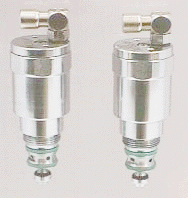-
About us
- Products
- Services
- Contact
APSON Products 2015.11.10
Catalogue ~ 6.3 MB Download
=O=
3/2-Ways Lacquer Valve VNT-2004
Prospect ~ 0.08 MBDownload
1. Introduction to top
The APSON 3/2-Ways Lacquer Valve 2004 is a pneumatically
controllable compact needle valve made of inoxidable steel. It fulfills
its function together with modules intended therefore, e.g. valve blocks,
lacquer distributors, sprayheads, a.o. Valves of this type are designed as
3/2-ways valves for aggressive non-granular fluid media, e.g. lacquers,
solvent, caustic solutions, a.o. They serve for switching the medium
stream into two from each other separated media circuits.

APSON 3/2-Ways Lacquer Valve 2004
2. Features to top
-
Fast error recognition in the lacquer system by directly evident switching status.
-
Early detecting of leakage of the medium as well as the pneumatics air.
-
Manual toggling of the valve with a special tool possible.
-
Fast valve exchange, and efficient maintenance and spareparts management.
-
Small pressure losses between medium inlet and medium outlets.
-
Very good rinsing characteristics, because of APSON deadthroom-free valve technology.
-
Very compact design.
3. Structure and Function to top
The valves consist of the drive in the pneumatics chamber, a seal
packing in the intermediate chamber and the two medium seals in the medium
chamber (actual valve). The valves have a mechanical visual display of the
switching status.

APSON 3/2-Ways Lacquer Valve 2004
The drive consists of the pneumatic cylinder, a
piston with sealing diaphragm, the valve needle and the pre-compressed
spring for closing the valve, if the valve is not addressed with
compressed air. The piston and the valve needle are rigidly connected
together.
The seal packing (medium barrier) consists of
several seals, which manage the sealing at the valve needle by means of a
pre-compressed spring, on the one hand to the medium chamber and on the
other hand to the pneumatics chamber.
The medium seals consist of the valve needle
head and two seals, which withstand aggressive media. All seals of the
valve must therefore be adapted to the media which are to be used.
The mechanical visual display consists of a
display pin for the switching status of the valve. The display pin is
rigidly connected with the valve needle. The valve can be switched by
pulling on the display pin manually. Optionally the possibility exists for
sensing electrically the status of the valve by means of a proximity
sensor.
In the screwed in status with the appropriate valve block, the valve
forms one discrete medium chamber, with one inlet and two outlets each
with axial sealing seats for the medium.
The outlet wich in normal condition (without control signal) is
closed is called normally closed outlet. The other
outlet is called thus normally open outlet.
In the inactive status (normal condition), no
compressed air or control signal pends, and the normally closed outlet is
closed and the normally open outlet is open.
In the active status, the valve is controlled
with compressed air, and the piston formed by the diaphragm connected with
the valve needle squeezes a spring together. Thereby the status of the
outputs is toggled and the normally closed output is opened and the
normally opened output is closed.
4. Technical Data to top
| Denomination: | APSON 3/2-Ways Lacquer Valve 2004 |
|---|---|
| Media: | Aggressive media (lacquer, solvent, caustic solution, a.o. |
| Medium pressure: | approx. 12 bar (or in accordance with customer's request) |
| Pneumatics air pressure: | 6 to 8 bar |
| Medium-touching housing parts: | Inoxidable steel |
| Piston seal: | Teflon™ |
| Main seals: | Teflon™ (optional Kalrez™) |
| Housing seals: | Viton™ |
5. Service Life to top
For the APSON 3/2-Ways Lacquer Valve 2004 the following service
lives were determined within the basecoat area. The service life for
valves, at operation with basecoat lacquer amounts to approx. 500,000
switching cycles. For a troublefree operation of this lacquer valve type,
all 300,000 switching cycles a visual inspection must be executed. The
visual inspection is to be executed first at the installed valve and
afterwards in the unscrewed status.
The installed valve must be outward absolutely tight:
-
If pneumatic air withdraws from the bleed bore (annular gap cover), the pneumatic seal at the piston must be exchanged.
-
If pneumatic air withdraws from the exhausting drilling of the valve needle, the piston sided seal (air side) of the valve needle for the pneumatic control air must be exchanged.
-
If lacquer withdraws from the exhausting drilling of the valve needle, the seal at the valve needle (lacquer side) must be exchanged.
At the unscrewed valve the following critical parts are to be
checked for wear:
-
Main seals of the needle
-
O-rings of the valve
-
Needle seals to compressed air side or lacquer side
Important: After approx. 300,000
switching cycles the compression spring in the pneumatics chamber must be
exchanged by a new greased compression spring. The exchange can be managed
without unscrewing the valve from its valveblock within one minute. For
safety reasons the medium should be switched pressure-free during the
exchange of the spring. Eventually the inner surface of the pneumatic
cylinder is to be coated again with valve fat.
6. Ordering Data to top
| Denomination | Part-Nr. |
|---|---|
| APSON 3/2-Ways Lacquer Valve 2004 | 060-A015 |
Options:
-
Main seal from Kalrez™
-
Non medium-touching housing parts from aluminum


